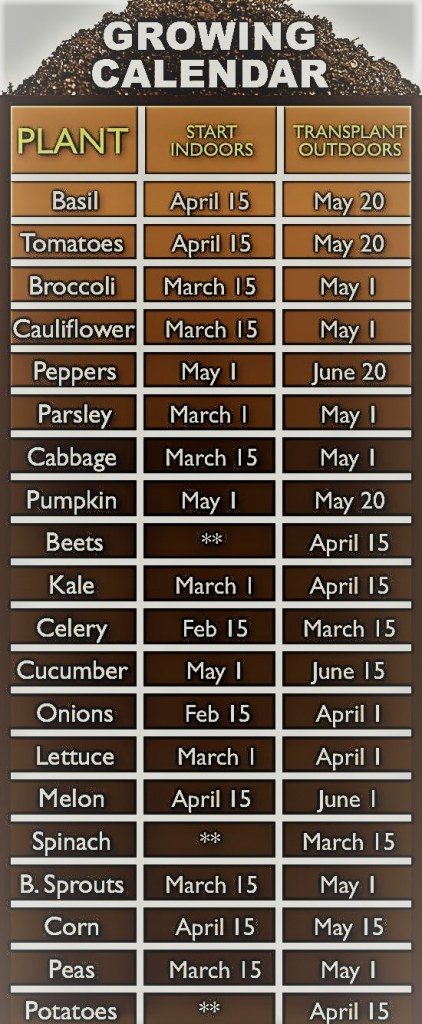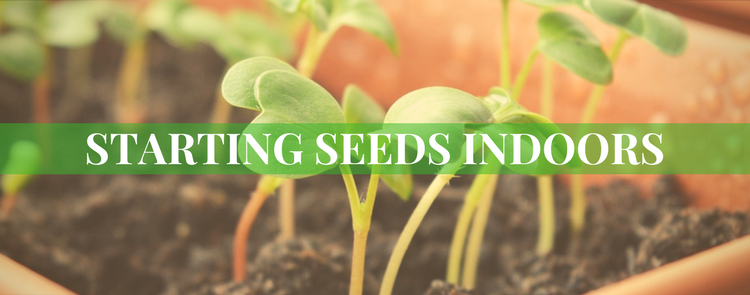Starting Seeds Indoors
Starting your seeds indoors will lessen the amount of time you have to wait to see results in your garden, and many people prefer to grow their plants indoors first to ready them for the growing season. It can be motivational and satisfying.
 If space is available near a sunny window, start seeds four to eight weeks before the plant-out date in your area (average date of last killing frost). Starting too early usually results in spindly plants due to crowding and lack of sufficient light.
If space is available near a sunny window, start seeds four to eight weeks before the plant-out date in your area (average date of last killing frost). Starting too early usually results in spindly plants due to crowding and lack of sufficient light.
Almost any container with drainage holes in the bottom will work for planting. Paper milk cartons cut in half, Styrofoam cups, tin cans, plastic trays and pots are common containers used. For convenience, however, you may wish to start plants in the plastic trays and pots available at garden supply centers.
Use a rich, well-drained soil when starting seeds indoor
Potting soils made for African violets and other house plants usually are suitable and do not have weed seeds. They are, however, more expensive than soil mixes you can make at home. If you use soil from the yard, it should be top soil that is well drained and not high in clay.
The best soils are often found around established shrubs and trees. Add sphagnum peat and sharp sand to the soil in a ratio of about one-half volume of each, and mixed thoroughly.
 To kill weed seeds and some damaging soil fungi present in your commercial soil, place the soil mix in shallow trays or baking pans in an oven for 45 minutes at 250 degrees. For best results, the soil should be moist.
To kill weed seeds and some damaging soil fungi present in your commercial soil, place the soil mix in shallow trays or baking pans in an oven for 45 minutes at 250 degrees. For best results, the soil should be moist.
Learn more about soil here
After the soil has cooled, fill containers firmly but do not pack. Allow about 3/4 inch from the soil surface to the rim of the container. Place seeds on the soil surface. Use a piece of window screen or old flour sifter to sift soil over the seeds to the depth indicated on the seed packet.
If you use compartmentalized trays or individual peat pots, place two or three seeds in each pot. Do not cover too deeply, as this may reduce or prevent seed germination.
Just like planting directly in the ground, a general rule is to cover no more than four times the diameter of the seed.
Apply a fine spray of water to avoid washing the seed, causing them to float to the soil surface. Household window sprayers are suitable.
Cover the containers with plastic sheets or panes of glass and place in a cool room (60 to 65 degrees) away from direct sunlight until germination. By doing this, you will almost eliminate the necessity of watering the bed again before the seeds germinate. Be sure to keep an eye on it though. DON’T let it completely dry out!
Germination can take anywhere from a few days to a couple of months, depending on what you are growing, so patience will have to be on of your virtues.
 When seeds germinate, move them gradually (over two or three days) into brighter light. When the seedlings have developed the first true leaves (the leaves above the cotyledons or “seed leaves”), thin to one plant per container
When seeds germinate, move them gradually (over two or three days) into brighter light. When the seedlings have developed the first true leaves (the leaves above the cotyledons or “seed leaves”), thin to one plant per container
if using partitioned trays or peat pots. Use tweezers to pinch off unwanted seedlings rather than pulling them, to avoid disturbing the remaining seedling.
If seeds were planted in larger containers, transplant into individual peat pots or other small containers. An alternative is to thin the seedlings so they are spread about 1 1/2 to 2 inches apart and leave them in the larger containers. This method, however, makes inefficient use of seed and space.
Water your seedlings carefully. Small containers used for starting plants dry out quickly. On the other hand, soil kept soaking wet inhibits seedling growth and may kill the plants.
About one week prior to planting-out time, gradually expose seedlings to longer periods outdoors unless temperatures are below 50 degrees. At the same time, reduce watering to a minimum as long as plants do not wilt.
This will help the plants adjust to full exposure without undergoing undue shock at planting time.
When it comes time for planting in the ground, carefully remove the plant from its container keeping the roots intact.
Dig a small hole in the garden plot and place the plant into the hole. Cover up the roots completely nearly up to the bottom leaves of the plant. Pack down the soil around the plant and water!




Comments are closed, but trackbacks and pingbacks are open.